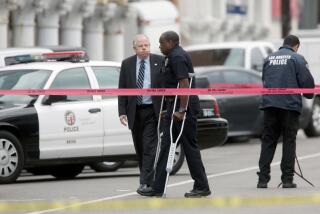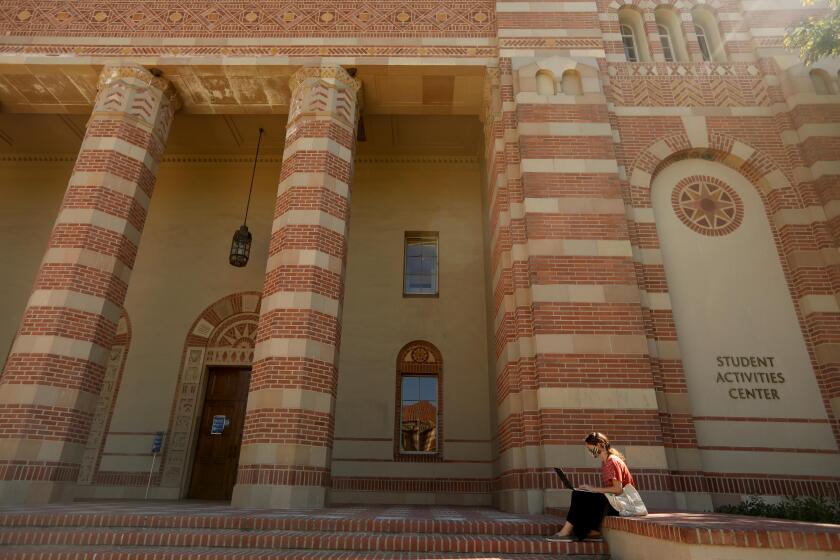Community Must Back Effort to Curb Violence, Frustrated Police Say
- Share via
Long before a bloody drive-by attack last week increased Venice’s death toll from shootings even further, Los Angeles police were going all-out to stop such carnage.
The LAPD’s Pacific Division had increased patrols, even bringing in officers from the Downtown Metro Division. A host of outside law enforcement agencies and gang intervention groups had also stepped in to offer assistance. There were city rewards and community meetings.
But nothing seemed to work. In part, police and city officials say, that is because residents in the most violent part of Venice--the Oakwood area--have been unwilling to tip off police about the identities of the gunmen.
“Everyone is very frustrated because we realize we are still missing the real grass-roots information,” said Ruth Galanter, who represents Venice on the Los Angeles City Council. “I have heard people (from) other parts of the city come in and say they will turn in their kids for a crime. . . . They say, ‘We would rather see them in jail than in a coffin.’ Well, we are not seeing anything close to that in Oakwood.”
In last Friday’s shooting on Venice Boulevard, two teen-agers died and two others were wounded when gunmen in a van opened fire on the occupants of a red Hyundai parked outside a Venice Boulevard pager store. The four victims, none of whom is believed to be a gang member, were Latinos enrolled at Dorsey High School. The three assailants were described as blacks.
The attack came amid a surge in shootings in and around the Oakwood area by black and Latino gangs that in the past year have claimed at least 17 lives and left more than 50 people injured. It was one of three shootings Friday that prompted the LAPD’s latest show of force in Venice.
Immediately after the attacks, the department beefed up its deployment: Officers were put on 10-hour shifts, some worked their regular days off, and an additional 50 officers from other Westside divisions were put on patrol in so-called mobile field forces.
But the deployment did not have an immediate impact on the violence. Five hours after the Venice Boulevard killings, as dozens of officers fanned out on patrols, four men in a car drove through Oakwood and opened fire on a crowd, wounding a 14-year-old boy.
“Now what causes that? A lack of fear of police? I doubt that’s the case,” Lt. Otis Dobine of Pacific Division said this week. “It is just frustrating to know that you are throwing out everything you can at a given time. And it is not having any impact.”
One reason, according to Dobine and others, is that the sheer volume of gang violence--fueled by rivalries between Venice’s black and Latino gangs--makes it impossible for authorities to curb all the attacks.
“You can’t predict these shootings,” Dobine said. “The only (thing) you can predict is that if a black gang member is killed, you are going to expect some retaliation where a Hispanic will be killed.”
The difficulty of preventing such violence--and arresting those responsible for it--was underscored last Friday morning when officers arrived at one Venice shooting scene 45 seconds after an attack and were still unable to locate the gunmen.
“(The violence) is unprecedented and clearly inexcusable and the only way you are going to do anything about it is with involvement of the community,” Galanter said. “I mean, when cops can get there in 45 seconds and still can’t catch the suspects, you need some outside help.”
Since last fall, the LAPD has enlisted the views of public and private agencies ranging from the Venice Family Health Clinic to the FBI, said Capt. Richard LeGarra, who commands the Pacific Division. In private meetings and community forums, the department has worked with private foundations, nonprofit agencies and other law enforcement organizations to reach into the community, he said.
But for all the talking and planning, he and others say, the shootings have continued because there has not been enough community support.
Some Oakwood residents say the Police Department unfairly picks on young black and Latino men and is more attentive to the interests of affluent residents who have moved into the area.
But according to police, residents sometimes fail to provide information because they are protecting friends or relatives. Then, of course, there are the residents who do not help simply out of fear.
“People come to government and say, ‘You fix it.’ Well, government can’t fix things without the cooperation of the community,” Galanter said. “They don’t have to come to meetings. They don’t have to make speeches. We don’t want them to be in danger. But they have to cooperate. They have to contribute.”
The Pacific Division has set aside two phone lines for the public. The first, (310) 390-0453, channels calls to an answering machine, where citizens can either leave information or listen to a recorded message about area gang violence. The second line, (310) 202-4579, leads to the division’s detective bureau, where callers can leave information anonymously.
“I am really at a loss to tell you how we are gonna solve this thing. We sit here and talk and I don’t have a solution,” LeGarra said this week. “Even before the shooting Friday, I was talking to people to try and come up with something.”
More to Read
Sign up for Essential California
The most important California stories and recommendations in your inbox every morning.
You may occasionally receive promotional content from the Los Angeles Times.










